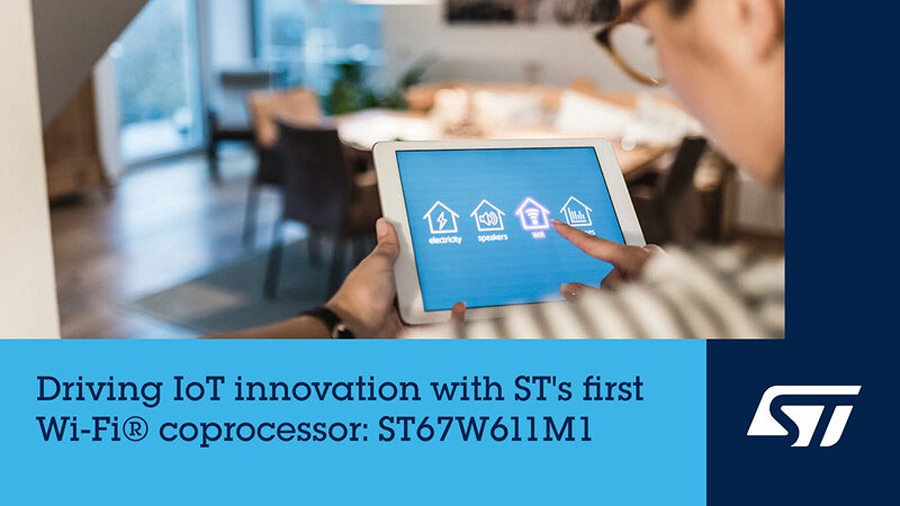
GENEVA, Switzerland, June 6, 2025 – STMicroelectronics has announced the start of mass production for its ST67W611M1 module, which combines Wi-Fi 6 and Bluetooth Low Energy 5.4. Siana, an early customer, has adopted this connectivity solution.
The module is the first result of the 2024 collaboration between ST and Qualcomm Technologies, developed to simplify implementation of wireless connectivity in systems using STM32 microcontrollers (MCUs). It combines ST’s embedded systems and STM32 development ecosystem with Qualcomm’s wireless connectivity technology into a single integrated solution.
“Wireless connectivity is a key enabler for the cloud-connected intelligent edge and demand for smart, connected devices continues to expand and accelerate throughout consumer and industrial markets,” said Jerome Vanthournout, connectivity business line director, STMicroelectronics. “Mastering the complex Wi-Fi and Bluetooth protocols, and bringing that connectivity to devices and IoT applications, are huge challenges. Our modular solution, created with industry-leading knowhow of all aspects, lets product developers focus their resources at the application level and bring new products to market quickly.”
Shishir Gupta, senior director, product management at Qualcomm Technologies, Inc. added, “Qualcomm Technologies is thrilled to see the impact of our collaboration with STMicroelectronics through the ST67W module. This module, which contains Qualcomm Technologies’ wireless connectivity components, not only simplifies the integration of Wi-Fi and Bluetooth into a wide range of devices powered by STM32 microcontrollers but also offers incredible flexibility and scalability. This module is a testament to our joint commitment to driving innovation and excellence in the IoT space.”
The ST67W module is ready to integrate with any STM32 MCU and contains a Qualcomm Technologies multiprotocol network coprocessor and 2.4GHz radio. All RF front-end circuitry is built-in, including power/low-noise amplifiers, the RF switch, balun, and integrated PCB antenna, with 4Mbyte Flash for code and data storage and a 40MHz crystal. The module comes pre-loaded with Wi-Fi 6 and Bluetooth 5.4 and is pre-certified. Thread and Matter will be supported soon via software update. There is also an optional coaxial antenna or board-level connections for an external antenna. Security is handled with cryptographic accelerators and services including secure boot and secure debug reaching PSA Certified Level 1, so that customers can comply with the upcoming Cyber Resilience Act and RED directives.
Packaged in a 32-lead LGA format, the module is designed for placement on the board and supports PCB layouts, including two-layer configurations. Siana Systems is among the first IoT technology companies to explore the opportunities this wireless connectivity module brings to enhance product performance and accelerate time to market.
“The ST67W module expands opportunities to add Wi-Fi to devices powered by various STM32 microcontrollers and worry less about the minimum requirements. We can simply integrate the module and quickly get Bluetooth and Wi-Fi connectivity, with minimal additional engineering, which provides us with a simple go-to solution for our next generation designs,” said Sylvain Bernard, founder and solution architect, Siana Systems. “The module’s RF performance, with the radio and front-end circuitry integrated, is very strong, and the flexible power management with fast wake-up times lets us create extremely energy-efficient new products.”
The ST67W611M1 leverages the STM32 ecosystem, which contains over 4,000 commercial part numbers, STM32Cube tools and software, and enhancements that boost edge AI development. The STM32 family covers a broad spectrum from economical Arm Cortex-M0+ devices to variants with cores like Cortex-M55, Cortex-M4 with DSP extensions, and Cortex-A7 in the STM32MP1/2 MPUs.
Source: STMicroelectronics
About STMicroelectronics

STMicroelectronics, established in 1987 through the merger of Italy’s SGS Microelettronica and France’s Thomson Semiconducteurs, is a global semiconductor company headquartered in Geneva, Switzerland. The company offers a range of products, including analog chips, discrete power semiconductors, microcontrollers, and sensors, serving industries such as automotive, industrial, personal electronics, communications equipment, and computers. In 2023, STMicroelectronics reported revenues of $17.3 billion, with over 50,000 employees worldwide and offices in 40 countries. The company is committed to sustainability, aiming for carbon neutrality in scope 1 and 2 emissions, and partially scope 3, by 2027.
About Qualcomm Technologies

Qualcomm Technologies, Inc., a subsidiary of Qualcomm Incorporated, is a leading American semiconductor and wireless technology company headquartered in San Diego, CA. Established in 1985, the company specializes in designing and supplying integrated circuits and system software for wireless telecommunications. Its product portfolio includes Snapdragon processors, modems, and platforms utilized in smartphones, automotive systems, Internet of Things (IoT) devices, and industrial equipment. Qualcomm operates primarily through two segments: Qualcomm CDMA Technologies (QCT), which focuses on semiconductor products, and Qualcomm Technology Licensing (QTL), which manages its extensive patent portfolio. In fiscal year 2024, Qualcomm reported revenues of $38.96 billion, with the QCT division contributing $33.2 billion. The company serves a global clientele across various industries, including mobile, automotive, computing, and industrial sectors, leveraging its expertise in 5G, artificial intelligence, and low-power computing to drive innovation and connectivity worldwide.
